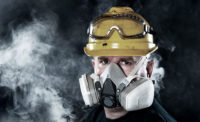OSHA Respiratory Protection 1910.134

History
OSHA's revised Respiratory Protection Standard (29 CFR 1910.134 and 29 CFR 1926.103) went into effect April 8, 1998. The final standard replaces the respiratory protection standards adopted by OSHA in 1971. Respiratory protection is addressed in standards specifically for the general, shipyard employment, marine terminals, longshoring, and construction industries. The respiratory protection standards for the shipyard employment (29 CFR 1915.154), marine terminals (29 CFR 1917.92), longshoring (29 CFR 1918.102), and construction industries (29 CFR 1926.103) reference the respiratory protection standard for general industry (29 CFR 1910.134).
Why this standard is important
An estimated 5 million workers are required to wear respirators in 1.3 million workplaces throughout the United States. The general industry standard protects the health of employees from harmful dusts, fogs, fumes, mists, gases, smokes, sprays, and vapors.
Hazards
Respirators protect workers against insufficient oxygen environments, harmful dusts, fogs, smokes, mists, gases, vapors, and sprays. These hazards may cause cancer, lung impairment, diseases, or death.
Enforcement Statistics
October 2015 through September 2016 – totals for all industries
Citations: 3,080
Inspections: 1,384
Penalty: $2,319,792
#4 on OSHA’s Top 10 Most Frequently Cited Standards
Most Frequently Cited Provisions
- A respirator shall be provided to each employee when such equipment is necessary to protect the health of such employee. The employer shall provide the respirators which are applicable and suitable for the purpose intended. The employer shall be responsible for the establishment and maintenance of a respiratory protection program.
- In any workplace where respirators are necessary to protect the health of the employee or whenever respirators are required by the employer, the employer shall establish and implement a written respiratory protection program with worksite-specific procedures. The program shall be updated as necessary to reflect those changes in workplace conditions that affect respirator use.
- The employer must establish and implement those elements of a written respiratory protection program necessary to ensure that any employee using a respirator voluntarily is medically able to use that respirator, and that the respirator is cleaned, stored, and maintained so that its use does not present a health hazard to the user.
Most cited industries
- Specialty Trade Contractors
- Fabricated Metal Product Manufacturing
- Repair and Maintenance
- Nonmetallic Mineral Product Manufacturing
- Transportation Equipment Manufacturing
- Chemical Manufacturing
- Machinery Manufacturing
- Merchant Wholesalers, Durable Goods
- Furniture and Related Product Manufacturing
- Construction of Buildings
What must employers do to protect employees?
Four major duties are imposed by the standard: use environmental controls where feasible to control the hazard; provide an appropriate respirator; ensure the use of an appropriate respirator, and institute a respiratory protection program.
Key Letter of Interpretation
There are no exemptions for small business anywhere in the standard. The annual fit testing requirement in the new Respiratory Protection Standard changes the semi-annual fit testing requirements in the substance specific standards. The changes to the substance specific standards such as the asbestos and lead standards, were also published in the January 8, 1998, Federal Register, and fit testing requirements for substance specific standards now follow the new Respiratory Protection Standard. The change in the fit testing frequency applies to all businesses and is not a specific exemption for small businesses.
Looking for a reprint of this article?
From high-res PDFs to custom plaques, order your copy today!







